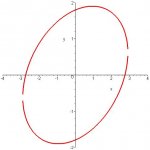skiwilly2001
New member
- Joined
- Apr 17, 2010
- Messages
- 1
My instructor didn't lecture but just wrote down the theorom and an example. That is all I have to help me. I can get started, but I am getting hung up a the point where you use the half-angle identity. Here is the problem : Find the equation on x y plane and sketch graph. 6x^2-6xy+14y^2-45=0 I know that cot2x=4/3 which means that cos2x=4/5 so I now understand that sinx=+/-sq rt(1-4/5)/2 and I come up with sinx=sq rt 1/10. I don't know where to go from here or if I am even correct to this point. I know the answer is18.4 degrees and (x')^2/9+(y')^2/3=1 and I know the graph. Can anyone help?

